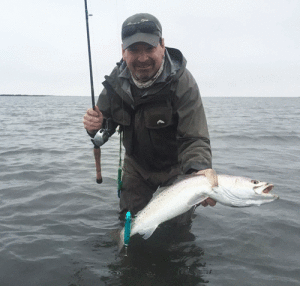
Captain Chris Martin on his 4th cast with top water lure in the low country of Seadrift. Fishing with Captain Ben Boudreaux. Trout was 4 pounds landed in the tail with blue chrome topwater.
As thermometer readings teeter-totter from one end of the spectrum to the other, the month of March can possibly be one of the most challenging months of the year for the coastal angler. The water temperature at Port O’Connor has risen to the 70-degree mark a couple times now, and coastal water temps will only continue to warm ever so slowly with the passing of each week. This transition to a warmer water climate will begin setting off the springtime alarm clock in the mind of the fish. It will signal to them a natural instinct for the necessity of change in their everyday activity and pattern, with their number one priority being the need for them to once again begin actively foraging a food supply. They are coming out of a pattern whereby they are used to expending the least amount of energy as necessary in order to capture a quick meal, and they will have an overwhelming desire to satisfy their appetite. Because of this, it will be crucial for anglers to key on active baitfish when scouting some of their more favorite and productive fishing spots at this time in the season.
This month’s successful anglers will also be the ones who learn to fish the signs and the conditions. For example, if you approach an area where baitfish happen to be busting in tea-stained or chocolate water, stop the boat, drop the power pole, and setup a wade session. Don’t let the fact that the water is off-colored discourage you, especially with the presence of a high population of active baitfish.
Ever-changing winds and higher tides can do odd things to bay waters, but anglers can still manage some of their very best March trips in these somewhat strange conditions. Strong winds often stain the water clarity to the point of almost being brown, but the presence of the mullet should always convince you to take a serious look at the area. Situations like these mean you will be fishing the conditions that were presented to you, and not simply fishing a popular spot where you may have caught fish before.
In that we’re not even halfway through March yet, we’re still going to be in store for some north winds over the course of the next couple months. Now, those who are somewhat familiar with our region might know that north winds will shutdown the trout bite altogether over the shell reefs that are located out in San Antonio Bay (SAB) proper – SAB will be completely blown-out, and can even be downright dangerous under these conditions. This being the case, anglers will need to continue to focus their fishing endeavors based upon some of the prosperous patterns that they may have happened upon in the past under these conditions at this same time of the year. And at those times when the northerly winds tend to persist, anglers may need to look for brief alternatives that match the conditions.
A lot of people have recognized extreme success during periods of strong north winds while concentrating their work on the north side of the Intracoastal Waterway (ICW) – areas rich in grass flats and coves. Strong blows out of the northeast will supply blue water along the north edge of the ICW, and many prized red fish have been landed where anglers have located streaks of dirty water mixed amongst the blue. And because many of these northern fronts can present us with little, if any, daylight sunshine for a period of days, anglers should target the reds by either wading or drifting these ICW locales during an incoming tide while casting more natural-looking and darker-colored top water baits back toward the ICW drop-off areas. Granted, a forceful wind often makes for dirty and choppy waters, but you should never give up on the use of your top waters. They will work, regardless of these conditions. As for the trout, look to locate leeward grass points just off of the ICW. These areas should be holding small glass minnows and mullet right about now, and many nice trout have been taken on plastics rigged with 1/8-ounce jig heads when fishing over ICW shorelines configured of mixed shell, soft mud, and sand.
Slow, warming temperatures indicate to us that spring is right around the corner, and there will be definite added boat traffic as a direct result. I encourage everyone to be safe, and to give each other plenty of playing space – there’s room for us all out there. Remember to practice CPR, “Catch, Photo, and Release”, whenever possible on trophy Trout and Reds…Guide Chris Martin, Port O’Connor/Seadrift region. www.BayFlatsLodge.com…1-888-677-4868
